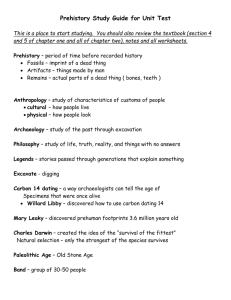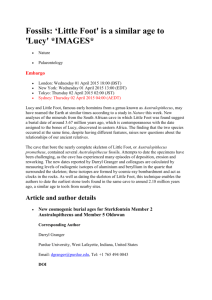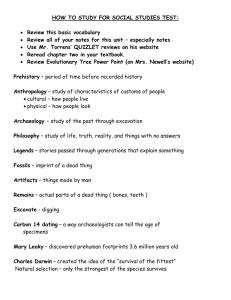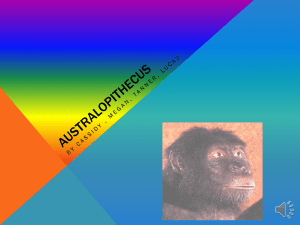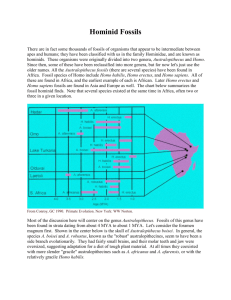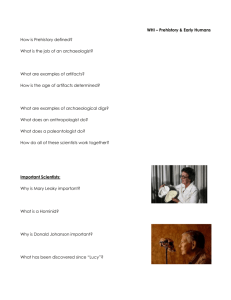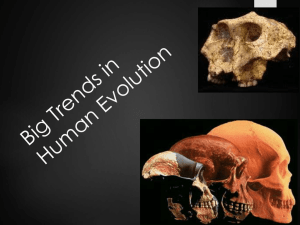Genus Australopithecus
advertisement
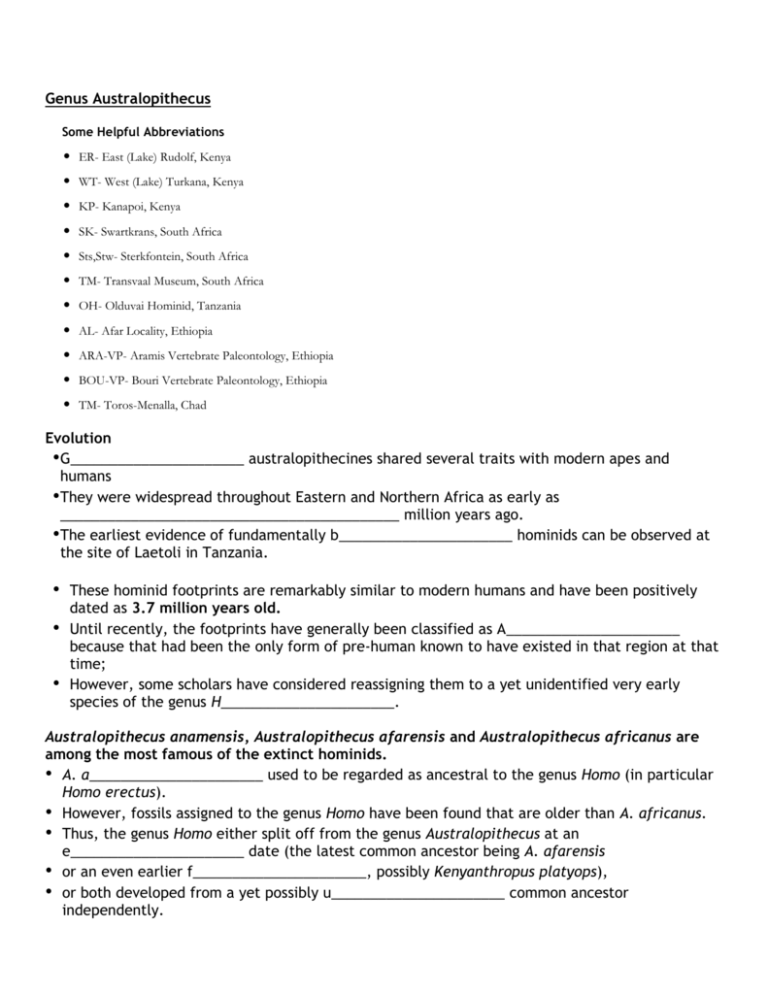
Genus Australopithecus Some Helpful Abbreviations • • • • • • • • • • • ER- East (Lake) Rudolf, Kenya WT- West (Lake) Turkana, Kenya KP- Kanapoi, Kenya SK- Swartkrans, South Africa Sts,Stw- Sterkfontein, South Africa TM- Transvaal Museum, South Africa OH- Olduvai Hominid, Tanzania AL- Afar Locality, Ethiopia ARA-VP- Aramis Vertebrate Paleontology, Ethiopia BOU-VP- Bouri Vertebrate Paleontology, Ethiopia TM- Toros-Menalla, Chad Evolution •G______________________ australopithecines shared several traits with modern apes and humans •They were widespread throughout Eastern and Northern Africa as early as ___________________________________________ million years ago. •The earliest evidence of fundamentally b______________________ hominids can be observed at the site of Laetoli in Tanzania. • • • These hominid footprints are remarkably similar to modern humans and have been positively dated as 3.7 million years old. Until recently, the footprints have generally been classified as A______________________ because that had been the only form of pre-human known to have existed in that region at that time; However, some scholars have considered reassigning them to a yet unidentified very early species of the genus H______________________. Australopithecus anamensis, Australopithecus afarensis and Australopithecus africanus are among the most famous of the extinct hominids. • A. a______________________ used to be regarded as ancestral to the genus Homo (in particular Homo erectus). • However, fossils assigned to the genus Homo have been found that are older than A. africanus. • Thus, the genus Homo either split off from the genus Australopithecus at an e______________________ date (the latest common ancestor being A. afarensis • or an even earlier f______________________, possibly Kenyanthropus platyops), • or both developed from a yet possibly u______________________ common ancestor independently. • According to the Chimpanzee Genome Project, both human (Ardipithecus, Australopithecus and Homo) and chimpanzee (Pan troglodytes and Pan paniscus) lineages diverged from a common ancestor about ______________________million years ago, if we assume a constant rate of evolution. • It is theoretically more likely for evolution to happen slower (older), as opposed to quicker, from the date suggested by a gene clock (the result of which is given as an "youngest common ancestor", i.e. the latest possible date of diversion.) • However, more r______________________ discovered hominids are somewhat o______________________ than the molecular clock would theorize. • Sahelanthropus tchadensis, commonly called "Toumai" is about ______________________old and Orrorin tugenensis lived at least ______________________ago; • the location of the m______________________ of both indicate that they were bipedal and had therefore diverged from the common ancestor much further back along the evolutionary trail. Sahelenthropus tchadensis- TM 266 • The fossil skull TM 266, nicknamed "Toumaï" ("hope of life" in the local Goran language of Chad), may be a common ancestor of humans and chimpanzees; • Most molecular clocks suggest humans and chimps d______________________ 1–2 million years a______________________ S. tchadensis (5 mya). • The original placement of this species as a human ancestor but not a chimpanzee ancestor complicated the picture of the human family tree. • Another possibility is that Toumaï is a______________________ related to both humans and chimpanzees, but the ancestor of neither. • Brigitte Senut, the discoverer of Orrorin tugenensis, claims that the features of S. tchadensis are consistent with a female p_______-g______________________. • If Senut's claims are true the find would lose none of its significance, for at present precious few chimpanzee or gorilla ancestors have been found anywhere in Africa, thus if S. tchadensis is an ancestral relation of the chimpanzees the first light would be shed on their family trees. Orrorin tugenensis • Orrorin tugenensis lived at least 6 million years ago; – M______________________ Ancestor Estimated age: 6 million years Date of discovery: 2000 Location: Kapsomin, Kenya • Evidence for this species is made up of 13 fossils, including a partial femur, bits of a lower jaw, and several teeth. • • One of the few things about O. tugenensis that is not controversial is its a_________. Sediments in which the bones were found have consistently been dated at 6 million years old, making O. tugenensis the oldest hominid after Toumai, if in fact the species is a hominid. • Since little is known of them, they remain controversial among scientists since the m______________________ clock in humans has determined that humans and chimpanzees had an evolutionary split at least a million years later. • One theory suggests that humans and chimpanzees diverged once, then i______________________ around one million years after diverging. • As molecular evidence has accumulated, the constant-rate assumption has proven false—or at least overly general. • However, while the molecular clock cannot be blindly assumed to be true, it does hold in many cases, and these can be tested for. Morphology- Brain Size • The brains of most species of A______________________ were roughly _____% of the size of that of a modern human brain. Morphology- Stature • Most species of Australopithecus were diminutive and g______________________, usually standing no more than 1.2 and 1.4 m (approx. ______________________feet) tall. • In several variations of Australopithecine there is a considerable degree of s______________________ d______________________, meaning that males are larger than females. • Modern hominids do not appear to display sexual dimorphism to the same degree• Particularly, modern humans display a low degree of sexual dimorphism, with males being ____% larger than females, on average. • In Australopithecines, males can be up to _____% larger than females. • New research suggests that sexual dimorphism may be far less pronounced than this, but there is still much debate on the subject. Species variations • Although opinions differ as to whether the species aethiopicus, boisei and robustus should be included within the g______________________ Australopithecus, the current consensus in the scientific community is that they should be placed in a distinct genus, P______________________, which is believed to have developed from the a______________________ Australopithecus line. • Up until the last half-decade, the majority of the scientific community included all the species shown in a single genus. • Paranthropus, being more massive and robust, was also morphologically distinct from Australopithecus, and its specialized physiology also implies that its b______________________ was quite different from that of its ancestor. Evolutionary role • The fossil record seems to indicate that Australopithecus is the common ancestor of the distinct group of hominines, now called Paranthropus (the "robust australopithecines"), and most likely the genus Homo which includes modern humans. • Although the i______________________ of these early hominines was likely no more sophisticated than modern apes, the bipedal stature is the key evidence which distinguishes the group from previous primates who are quadrupeds. • If A. afarensis was the definite hominine which left the footprints at Laetoli, it strengthens the notion that A. afarensis had a s__________ b____________but was a biped. • Fossil evidence such as this has made it clear that b______________________ far predated large b______________________. Evolution of Bipedalism • However, it remains a matter of controversy how bipedalism first evolved millions of years ago (several concepts are still being studied). • The advantages of bipedalism allowed hands to be free for g______________________ objects (e.g. carrying food and young), and allowed the eyes to look over tall grasses for possible food sources or p______________________. • However, many anthropologists argue that these advantages were not large enough to cause bipedalism. • A recent study of primate evolution and morphology noted that all apes, both modern and fossil, show skeletal adaptations to upright posture of the trunk, and that fossils such as Orrorin tugenensis indicate bipedalism around 5 to 8 millian years ago, around the time of the split between humans and chimpanzees indicated by genetic studies. • This suggested that that upright, straight-legged walking originally evolved as an adaptation to t____________________________________________. • Studies of modern o______________________ in Sumatra showed that these apes: • use f______________________ legs when walking on large stable branches, • s______________________ underneath slightly smaller branches, but are • bipedal and keep their legs very straight when walking on multiple small f______________________ b______________________ under 4 cm. diameter, while also using their arms for balance and additional support. • This enables them to get n______________________ to the edge of the tree c______________________ to get fruit or cross to another tree. • Climate changes around 11 to 12 million years ago affected forests in East and Central Africa so that there were periods when o______________________ prevented travel through the tree canopy, and at these times ancestral hominids could have adapted the upright walking behavior for g______________________ travel. • It is suggested that the ancestors of gorillas and chimpanzees became more specialized in climbing vertical tree trunks or lianas, using a bent hip and bent knee posture which matches the knuckle-walking posture they use for ground travel. • Humans are closely related to these apes, and share features including wrist bones apparently strengthened for k______________________ walking • Radical changes in morphology took place before gracile australopithecines evolved; • the p______________________ structure and feet are almost indistinguishable in comparison to modern humans. • The t______________________ are aligned just as modern humans with small canines; however, Paranthropus evolved a larger thicker dentition. • Australopithecines faced one particular challenge while living on the savanna. • They were the s______________________-moving primates at the time and many fell prey to carnivorous creatures (lions and the extinct Dinofelis). Tool use • Most species of Australopithecus were not any more adept at tool use than modern non-human primates, • Modern African apes, chimpanzees, and most recently gorillas, have been known to use s______________________tools • (i.e. cracking open nuts with stones and using long sticks to dig for termites in mounds), and chimpanzees have been observed using spears (not thrown) for hunting. • However, Australopithecus garhi does appear to have been the most advanced of the line with its presumably older stone tool artifacts than the earliest genus homo member known so far, Homo habilis. • A. garhi's remains have been found with t______________________ and b______________________ animal remains, suggesting the incipience of a very primitive tool industry. • This led many scientists to suspect that A. garhi may be the ancestor of the Homo genus. • However, further evidence may help anthropologists and scientists to determine the true ancestor species. Diet • In a 1979 preliminary m______________________ study of Australopithecus fossil teeth, anthropologist Alan Walker theorized that Austrolopithecus may have been f______________________. • However, newer methods of studying fossils have shown that Australopithecus was likely o______________________. • In 1992, isotope studies of the strontium/calcium ratios in Australopithecus fossils showed that the species almost certainly consumed a______________________. • These findings were confirmed in 1994 using stable carbon isotopic analysis. Notable Specimens of Australopithecus Laetoli footprints • Estimated age: 3.6 million years Date of discovery: 1978 Location: Laetoli, Tanzania • Species: Australopithecus a______________________ • These fossilized footprints reveal important information about the two individuals (3?) who made them. First, it's clear that they walked u______________________. Also, from stride length, scientists estimate that they were about ______________________inches and 4 feet tall, respectively. • (The footprints are linked to A. afarensis by the fossil jawbones of the same species found nearby.) AL 129-1 • Estimated age: 3.4 million years Date of discovery: 1973 Location: Hadar, Ethiopia • Species: Australopithecus a______________________ • This intact A. afarensis k______________________ joint looks very much like a small version of an anatomically modern human knee and likely worked similarly. • The angle of the joint all but confirms A. afarensis's ability to walk upright. DIK-1/1, Selam • Estimated age: 3.3 mya • Date of discovery: 2000 • Location: D______________________, Afar Depression, Ethiopia • Species: Australopithecus afarensis • Selam (DIK-1/1) is the fossilized skull and other skeletal remains of a ______________________old Australopithecus afarensis female • The recovered skeleton comprises almost the entire skull and torso, and many parts of the limbs. • The features of the skeleton suggest adaptation to walking upright (bipedalism) as well as treeclimbing, features that correspond well with the skeletal features of Lucy and other specimens of Australopithecus afarensis from Ethiopia and Tanzania. Lucy • Estimated age: 3.2 million years Date of discovery: 1974 Location: Hadar, Ethiopia • Species: Australopithecus afarensis • Analyses show that Lucy was approximately ______________________inches tall, weighed 62 pounds, and was 25 years old when she died. • This is the most complete A. afarensis skeleton yet described. STS-5: Mrs. Ples • Estimated age: 3 to 2 million years Date of discovery: 1947 Location: Sterkfontein, South Africa • Species: A. a______________________ • This adult cranium, most likely from a female A. africanus, is the best specimen of the species discovered so far. STS 14 • Estimated age: 3 to 2 million years Date of discovery: 1947 Location: Sterkfontein, South Africa • Species: A. africanus • These remains of a small adult female include a nearly complete v______________________ column, a pelvis, some rib fragments, and part of a femur. • The pelvis is far more h______________________ than apelike and is strong evidence that A. africanus was bipedal. • Some scientists have proposed that STS 14 may have come from the same individual as STS 5. STS 71 • STS 71 is a fossilized skull of the species Australopithecus africanus. It was discovered in Sterkfontein, South Africa by Robert Broom in 1947. • In 1972 John Wallace connected STS 71 with STS 36, a lower jaw found in the same layer, by matching the wear patterns on the teeth. STS 71 Taung Child • Estimated age: 3 to 2 million years Date of discovery: 1924 Location: Taung, South Africa • Species: A. africanus • Collected by workers in a lime quarry, this was the f______________________ Australopithecus fossil ever discovered. • The scientific community initially rejected the identification of this partial skull, saying that it was some sort of e______________________ ape species rather than an early form of hominid. Australopithecus garhi • Earliest stone tools (debated) Estimated age: 2.5 million years Location: Gona, Ethiopia • Australopithecus garhi may represent an evolutionary link between the genera of Australopithecus and Homo. • Circumstantial evidence suggests that A. garhi may have been the earliest t______________________ user. • Antelope fossils excavated from the same site as A. garhi show cut marks made by a stone tool; both the hominid and antelope fossils are dated at 2.5 million years old. • The earliest stone tools, thought to be 2.6 million years old, were found nearby in Gona, Ethiopia. References • Barraclough, G. (1989). in Stone, N. (ed.): Atlas of World History, 3rd edition, Times Books Limited. ISBN 0-7230-0304-1. • Leakey, Richard (1994). The Origins of Human Kind. ISBN 0-465-03135-8. • White, Tim D., et al. "Asa Issie, Aramis and the Origin of Australopithecus." Nature 440 (April 13, 2006), 883-89. • Bower, Bruce (May 20, 2006). "Hybrid-Driven Evolution: Genomes show complexity of humanchimp split". Science News 169 (20): 308. • BBC - Science & Nature - The evolution of man. Mother of man - 3.2 million years ago. Retrieved on 2007-11-01. • Thorpe S.K.S.; Holder R.L., and Crompton R.H. (24 May 2007). PREMOG - Supplementry Info. Origin of Human Bipedalism As an Adaptation for Locomotion on Flexible Branches. Primate Evolution & Morphology Group (PREMOG), the Department of Human Anatomy and Cell Biology, the School of Biomedical Sciences at the University of Liverpool. Retrieved on 2007-1101. “Based on computer simulations of the mechanics of motion in fossil human ancestors such as the famous 'Lucy' skeleton, our research group has long argued that early human ancestors would have walked upright, rather than semi-crouched, as the old 'up from the apes' view has suggested ... Now, research on the orangutan, suggests that upright walking may have been a basic element of the lifestyle of the earliest ancestors of modern apes, including humans, which would have been tree-dwelling specialists on ripe fruit, living among the fine branches of tropical forest trees.” • • Billings, Tom. Humanity's Evolutionary Prehistoric Diet and Ape Diets--continued, Part D). Billings, Tom. Comparative Anatomy and Physiology Brought Up to Date--continued, Part 3B).
